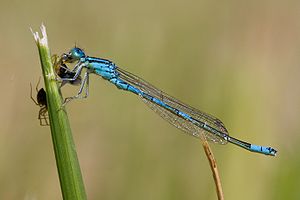Fork Azure Maiden
| Fork Azure Maiden | ||||||||||||
|---|---|---|---|---|---|---|---|---|---|---|---|---|

Fork azure maiden ( Coenagrion scitulum ); Males with prey. |
||||||||||||
| Systematics | ||||||||||||
|
||||||||||||
| Scientific name | ||||||||||||
| Coenagrion scitulum | ||||||||||||
| ( Rambur , 1842) |
The forked azure damsel ( Coenagrion scitulum ) is a dragonfly species from the family of the slender dragonflies ( Coenagrionidae ) that is mainly found in the Mediterranean region .
features
The forked azure maiden reaches a wingspan of three to four centimeters. The males are relatively smaller than other azure maidens and have black and blue markings on the thorax and abdomen segments. In the main distribution area, there is a risk of confusion with the more common - but not found in Germany - southern azure virgin ( C. caerulescens ). This has slightly smaller blue parts on the third and fourth abdominal segments and a slightly longer wing mark ( pterostigma ). However, it is very difficult to distinguish between the two species in photos and a reliable determination is usually only possible with the help of the front breast . For the first address in the field in southwest Germany, both males and females often use a clearly pronounced greenish-yellow color on the underside of the eyes, thorax and abdomen. Also striking are the bright wing marks (pterostigms), the "torpedo-shaped" drawing elements on the upper side of the abdomen of the female and the hook-like, inwardly curved upper abdominal appendages of the male.
distribution and habitat
The forked azure virgin lives in standing and flowing waters rich in vegetation in the northern Mediterranean area from Portugal to Asia Minor , partly also in North Africa . However, it also occurs as a reproductive guest in more northern latitudes. It had established itself in Essex , England from 1946 to 1953 . Reports of the species from Germany are so far very rare and are limited to Baden , Bavaria , North Rhine-Westphalia and Rhineland-Palatinate - the last three federal states also received the most recent records in 2006 and 2007. There are also recent finds from Switzerland . Especially in warmer years, sporadic occurrences of the species can be expected in Central Europe, up to the long-term settlement of suitable, heat-favored waters.
Way of life
The flight time of the Gabel-Azurjungfer falls from the middle of May to the beginning of September, the main flight time is June and July. The mating behavior corresponds to that of other azure virgins, but the males mainly fly above the water surface instead of in the vegetation. The sporadic finds of individual individuals of the species in Central Europe indicate a high degree of vagility. Very little is known about mating, oviposition and larval development.
Web links
literature
- B. Grebe, R. Hofland, J. Rodenkirchen: New records of Coenagrion scitulum in North Rhine-Westphalia (Odonata: Coenagrionidae). In: Libellula. 25, 2006, pp. 19-26.
- R. Hoess: Was Coenagrion scitulum (Rambur, 1842) (Odonata: Coenagrionidae) once native to Switzerland? In: Communications from the Entomological Society of Basel. 57, 2007, pp. 2-9.
- A. Karle-Fendt: First record of Coenagrion scitulum in Bavaria (Odonata: Coenagrionidae). In: Libellula. 25, 2006, pp. 129-134.
- G. Jurzitza: The Kosmos dragonfly guide . Franckh-Kosmos Verlag, Stuttgart 2000, ISBN 3-440-08402-7 .
- Dijkstra, K.-D .: Dragonflies of Europe: The destination guide. Haupt-Verlag 2014, ISBN 978-3-258-07810-6 .
